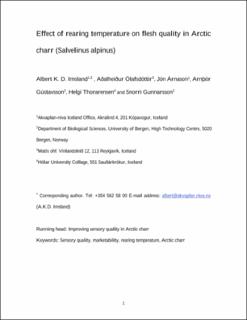Effect of rearing temperature on flesh quality in Arctic charr (Salvelinus alpinus)
Imsland, Albert; Ólafsdóttir, Aðalheiður; Árnason, Jón; Gústavsson, Arnþór; Thorarensen, Helgi; Gunnarsson, Snorri
Journal article, Peer reviewed
Accepted version
Permanent lenke
https://hdl.handle.net/11250/2989999Utgivelsesdato
2021Metadata
Vis full innførselSamlinger
- Department of Biological Sciences [2289]
- Registrations from Cristin [10402]
Sammendrag
Currently, no information is available on the effect of progressively decreasing temperatures on the sensory quality of Arctic charr. The objective of this study was to investigate if and how different and progressively changing rearing temperatures affect the sensory quality of cooked and raw fillets of Arctic charr. The effects of rearing temperature on the sensory quality of Arctic charr (weight range 622–888 g) were investigated. Rearing temperature was changed during the experimental period as the fish were reared at constant or decreased temperature during October to April and subsequently reared at two constant temperatures from April to August establishing six different rearing temperature combinations. Significant differences were seen in all four main sensory attributes groups, that is odour, appearance, flavour and texture. Freshness characteristics such as sweet odour and flavour, and metallic odour and flavour increased with decreasing rearing temperature, whereas musty odour and flavour decreased. Rearing temperature had a clear effect on the colour of the fillets. Lower rearing temperature increased colour intensity substantially. Softness, juiciness and tenderness increased with decreased rearing temperature. A trend was seen towards more effect from final rearing temperature than initial temperature on the sensory attributes studied. Spoilage characteristics, that is, sour and rancid odour and flavour, and off-odour and flavour were either very weak or not noticeable in all sample groups.
